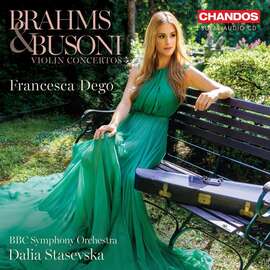Die beiden Violinkonzerte von Brahms und Busoni als Koppelung erscheinen auf den ersten Blick eher dem Motto ‘Gegensätze ziehen sich an’ zu gehorchen, da Brahms weitgehend als Traditionalist gesehen wurde und Busoni sich selber als Erneuerer einstufte. Busoni, der eine Generation Jüngere, bewahrte für Brahms immer Respekt. Brahms zeigte immerhin mit einem Empfehlungsschreiben, dass er dem noch sehr jungen Kollegen viel zutraute.
Das Konzert von Busoni zeigt sich mit solistischer Virtuosität, sinnlicher Melodik und luzider Instrumentation. Das Werk war immerhin so inspirierend, dass Sibelius das Duo von Violine und Fagott für sein eigenes Konzert übernahm. Während zeitgenössische Solisten wie Adolf Busch, Fritz Kreisler und Joseph Szigety das Konzert spielten, ist es heute selten zu hören.
Umso interessanter ist es, dass Francesca Dego sich des Werks annimmt. Man mag das Werk als unprätentiös ansehen. Formal entspannt mit rhapsodischem Charakter ergibt sich die Spannung aus nur wenigen Motiv- und Themenwiederholungen. Francesca Dego zeigt, dass sie diese feinen Elemente mit eloquenter und technischer Sicherheit beherrscht. Vom ersten Ton an zeigt sie ihr expressives Spielvermögen, das sie klanglich angereichert und voll mit Intensität anbietet, dabei aber raffiniert bleibt.
Auch im Konzert von Brahms bietet sie eine musikalisch gut geatmete Interpretation mit sicherem Stil- und Strukturgefühl an, so dass sie darüber auch die Verbindung von beiden Werken erzeugt. Während sie bei Brahms klassisch und elegant im Ton bleibt, lebt sie spätestens im Finalsatz von Busoni die hier angelegten karnevalesken Züge bis hin zum turbulenten Ende prägend aus.
Das BBC Symphony Orchestra bietet dazu unter der Leitung der finnischen Dirigentin Dalia Stasevska einen abgewogenen sicheren, immer dem Spiel der Solistin zugewandten Orchesterpart, der von der Sicherheit der Darstellung lebt.
At first glance, the two violin concertos by Brahms and Busoni as a pairing seem to follow the motto « opposites attract », as Brahms was largely seen as a traditionalist and Busoni classified himself as an innovator. Busoni, who was a generation younger, always maintained respect for Brahms. Brahms at least showed with a letter of recommendation that he had great confidence in his still very young colleague.
Busoni’s concerto is characterized by soloistic virtuosity, sensual melodies, and lucid instrumentation. The work was so inspiring that Sibelius adopted the duo of violin and bassoon for his own concerto. While contemporary soloists such as Adolf Busch, Fritz Kreisler and Joseph Szigety played the concerto, it is rarely heard today.
This makes it all the more interesting that Francesca Dego has taken on the work. The work may be regarded as unpretentious. Formally relaxed with a rhapsodic character, the tension arises from only a few repeated motifs and themes. Francesca Dego shows that she has mastered these subtle elements with eloquent and technical assurance. From the very first note, she demonstrates her expressive playing ability, which she offers enriched in sound and full of intensity, while remaining refined.
In the Brahms concerto, too, she offers a musically well-breathed interpretation with a sure sense of style and structure, so that she also creates a link between the two works. While she remains classical and elegant in tone in Brahms, in Busoni’s final movement at the latest she lives out the carnivalesque traits laid out here to the turbulent end.
Under the direction of Finnish conductor Dalia Stasevska, the BBC Symphony Orchestra offers a well-balanced, secure orchestral part that is always focused on the soloist’s playing and thrives on the security of the performance.




















